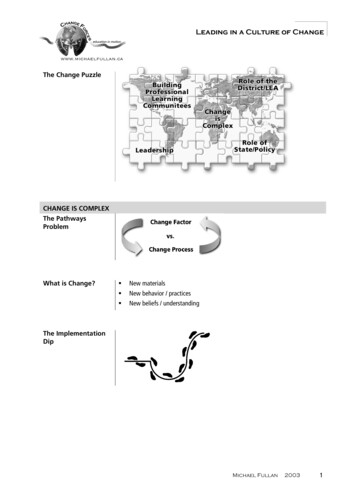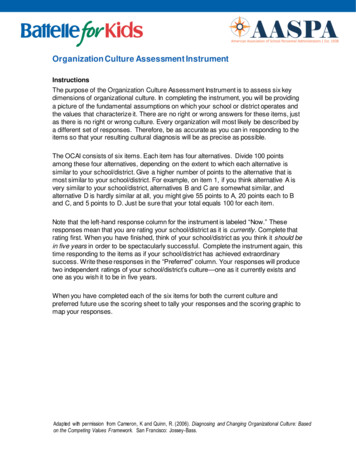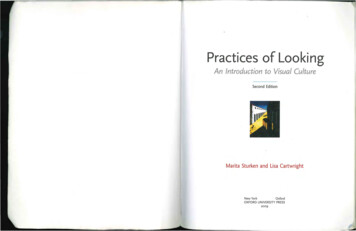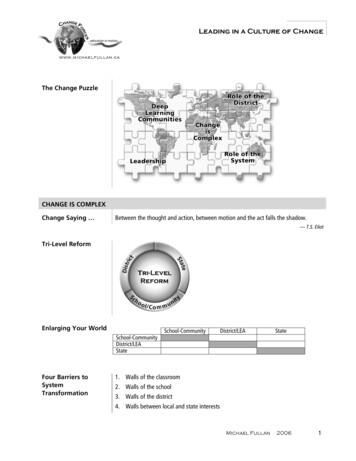
Transcription
Leading in a Culture of Changewww.michaelfullan.caThe Change PuzzleCHANGE IS COMPLEXThe PathwaysProblemWhat is Change?ßNew materialsßNew behavior / practicesßNew beliefs / understandingThe ImplementationDipMichael Fullan20031
Leading in a Culture of ChangeThe Complexityof Change1. You can’t mandate what matters.2. Change is a journey, not a blueprint.3. Problems are our friends.4. Vision and strategic planning come later.5. Individualism and collectivism must have equal power.6. Neither centralization nor decentralization works.7. Connection with the wider environment is critical for success.8. Every person is a change agent.— Fullan, Change Forces, 1993Eight Change Lessonsfrom Change ForcesWith A Vengeance1. Give up the idea that the pace of change will slow down.2. Coherence making is a never-ending proposition and is everyone’sresponsibility.3. Changing context is the focus.4. Premature clarity is a dangerous thing.5. The public’s thirst for transparency is irreversible.6. You can’t get large-scale reform through bottom-up strategies — but bewareof the trap.7. Mobilize the social attractors — moral purpose, quality relationships, qualityknowledge.8. Charismatic leadership is negatively associated with sustainability.— Fullan, Change Forces, 2003Brain BarriersBB #1: Failure to seeBB #2: Failure to moveBB #3: Failure to finish— Black & Gregersen, 2002BB #1: Failure to SeeßThe comprehensiveness mistake.ßThe ‘I get it’ mistake.ßIlluminate the right thing.— Black & Gregersen, 2002BB #2: Failure toMoveThe clearer the new vision the more immobilized people become! Why?— Black & Gregersen, 20022www.michaelfullan.ca
Leading in a Culture of ChangeRight Thing PoorlyThe clearer the new vision, the easier it is for people to see all the specific ways inwhich they will be incompetent and look stupid. Many prefer to be competent atthe wrong thing than incompetent at the right thing.— Black & Gregersen, 2002BB #3: Failure toFinishPeople get tired.People get lost.— Black & Gregersen, 2002Breaking ThroughBarriersßConceiveßBelieveßAchieve— Black & Gregersen, 2002At the beginning ofthe Change Process:ßThe losses are tangible and specificßThe gains are theoretical and distantInnovativeness notInnovationThe goal is not to manage innovations, but to become innovative.— D. GreenOverloadOverload & Fragmentation Incoherence & ConfusionLoss and ChangeNo one can resolve the crisis of reintegration on behalf of another. Every attemptto pre-empt conflict, argument or protest by rational planning, can only beabortive: however reasonable the proposed changes, the process of implementingthem must still allow the impulse of rejection to play itself out. When those whohave power to manipulate changes act as if they have only to explain, and whentheir explanations are not at once accepted, shrug off opposition as ignorance orprejudice, they express a profound contempt for the meaning of lives other thantheir own. For the reformers have already assimilated these changes to theirpurposes, and worked out a reformulation which makes sense to them, perhapsthrough months or years of analysis and debate. If they deny others the chance todo the same, they treat them as puppets dangling by the threads of their ownconceptions.— Peter Marris, 1975Michael Fullan20033
Leading in a Culture of ChangeLEADING IN A CULTURE OF CHANGEFramework forLeadership— Fullan, Leading in a Culture of Change, 2001Collins’ Hierarchy ofLeadershipLevel 5 Æ Executive(builds enduring greatness)Level 4 Æ Effective Leader(catalyzes commitment to vision and standards)Level 3 Æ Competent Manager(organizes people toward objective)Level 2 Æ Contributing Team Member(individual contribution to group objectives)Level 1 Æ Highly Capable Individual(makes productive contributions)— Collins, 20024www.michaelfullan.ca
Leading in a Culture of ChangeCollins’ Flywheel— Collins, 2002CharismaticLeadership is negatively associated with sustainability.Sustaining LeadersHave deep personal humility and intensive professional will.Michael Fullan20035
Leading in a Culture of ChangeMaking MattersWorseWhy DefaultStrategies Don’tWork Getting Beyond theWall“When we face resistance to our ideas, most of us react with an assortment ofineffective approaches. These are our default positions.”ßuse powerßplay off relationshipsßmanipulate those who opposeßmake dealsßapply force of reasonßkill the messengerßignore resistanceßgive in too soon and may often escalate and strengthen opposition to your goalsßthey increase resistanceßthe win might not be worth the costßthey fail to create synergyßthey create fear and suspicionßthey separate us from othersFive Fundamental Touchstones1. Maintain clear focusßkeep both long and short viewßpersevere2. Embrace resistanceßcounterintuitive responseßunderstand voice of resistance3. Respect those who resistßlisten with interestßtell the truth4. Relaxßstay calm and stay engagedßknow their intentions5. Join with the resistanceßbegin togetherßchange the gameßfind themes and possibilitiesConsider strategies that incorporate most (or all) of the touchstones!6www.michaelfullan.ca
Leading in a Culture of ChangeBUILDING PROFESSIONAL LEARNING COMMUNITIESForms of TeacherCultureFragmented IndividualismßIsolationßCeiling to improvementßProtection from outside interferenceBalkanizationßCity statesßInconsistenciesßLoyalties and identities tied to a particular groupßWhole is less than the sum of its partsCollaborative CultureßSharing, trust, supportßCenter to daily workß‘Family’ structure may involve paternalistic ormaterialistic leadershipßJoint workßContinuous improvementContrived CollegialityßStrategy for creating collegialityßAlso strategy for containing and controlling itßAdministrative procedureßSafe simulationMichael Fullan20037
Leading in a Culture of ChangeInfluences on SchoolCapacity and SchoolStudent AchievementStudent Achievement·Instructional QualityCurriculum, Instruction, Assessment·School Capacity- Teachers’ Knowledge, Skills, Dispositions- Professional Community- Program Coherence- Technical Resources- Principal Leadership·Policies & ProgramsonProfessional Development— Newmann, King & Youngs, 2000School CapacityThe collective power of the full staff to improve student achievement.School capacity includes and requires:ßKnowledge, skills, dispositions of individualsßProfessional communityßProgram coherenceßTechnical resourcesßPrincipal leadershipPedagogical andAssessment LiteracyTraditional Views8Traditional views of assessment are rapidly changing www.michaelfullan.ca
Leading in a Culture of ChangeAssessment LiteracyDefinition1. The ability to gather dependable student data.2. Capacity to examine student data and make sense of it.3. Ability to make changes in teaching and schools derived from those data.4. Commitment to communicate effectively and engage in external assessmentdiscussions.Effective SchoolsEffective schools are ones in which principals and teachers focus on studentlearning outcomes and link this information to improvements in teaching andlearning strategies.Three Patterns ofTeaching Practice1. Enacting traditions of practice2. Lowering expectations and standards3. Innovating to engage learners— McLaughlin & Talbert, 2001Communities ofPractice and the Workof High SchoolTeachers— McLaughlin & Talbert, 2001CreatingCollaborative CulturesHelps Teachers1. Build on existing expertise2. Pool resources3. Provide moral support4. Create a climate of trust5. Confront problems and celebrate successes6. Deal with complex and unanticipated problems7. Become empowered and assertive8. Incorporate lateral accountabilityMichael Fullan20039
Leading in a Culture of ChangeFour Dimensions ofTrust1. Respect2. Competence3. Personal regard for others4. Integrity— Bryk, 2002OrganizationalConsequences1. Enables risk and effort2. Facilitates problem-solving3. Coordinates clear collective action4. Sustains ethical and moral imperative— Bryk, 2002The 3 R’s of SchoolImprovementROLE OF THE DISTRICTSchool District ReformRecreating a School System.Letter off A, B, C, and the read the following: A B C - The District Context A - Instruction/Multistage Process (Lessons 1-2) B - Shared Expertise/Systemwide Improvement/Working Together (Lessons 3-5) C - Expectations/Collegiality (Lessons 6-7)Explain your section to your partners.— Elmore & Burney, 1999Re-Creating a SchoolSystem: Lessons 1-71. It is about instruction, and only instruction.2. Instructional change is a long, multistage process.3. Shared expertise is the driver of instructional change.4. Focus on systemwide improvement.5. Good ideas come from talented people working together.6. Set clear expectations, then decentralize.7. Collegiality, caring, respect.— Elmore & Burney, 199910www.michaelfullan.ca
Leading in a Culture of ChangeInvesting in Teaching LearningSource: Elmore, R.F., & Burney, D. (1999). In L. Darling-Hammond & G. Sykes (Eds.),Teaching as the Learning Profession, Handbook of Policy and Practice, pp. 266-271.The District ContextDistrict 2 is one of thirty-two community school districts in New York City that have primary responsibility forelementary and middle schools. District 2 has twenty-four elementary schools, seven junior high or intermediateschools, and seventeen so-called Option Schools, which are alternative schools organized around themes with avariety of different grade configurations. District 2 has one of the most diverse student populations of anycommunity district in the city. It includes some of the highest-priced residential and commercial real estate inthe world, on the Upper East Side of Manhattan, and some of the most densely populated poorer communitiesin the city, in Chinatown in Lower Manhattan and in Hell’s Kitchen on the West Side. The student population ofthe district is twenty-two thousand, of whom about 29 percent are white, 14 percent black, about 22 percentHispanic, about 34 percent Asian, and less than 1 percent Native American. About 20 percent of students useEnglish as a second language, and recent immigrants have come from about one hundred different countries.About 50 percent of students come from families whose incomes are officially classified as below the povertylevel; a slightly higher proportion of students in elementary schools are classified as poorer than in junior highschools. About two hundred students reside in temporary shelters, and about two thousand students receivespecial education services.The proportion of students living in poverty is between 70 percent and 100 percent in fourteen of the district’sschools, with five of those schools having proportions of poor children between 95 percent and 100 percent. Atthe other extreme, nine schools have proportions of poverty at 25 percent or below. District 2 has a thriving,diverse, middle-class population of families who take public education seriously, but who are also willing tomake financial sacrifices to send their children to readily available private schools if they find the quality ofpublic schools lacking. Principals speak consistently of having to win the loyalty and allegiance of middle-classparents through providing high-quality education. The schools and classrooms of District 2 are a virtual UnitedNations of diversity (the UN is actually in the district); every school has substantial racial, ethnic, and culturaldiversity, even when the student population is predominantly of one race or ethnicity. Most schools havesubstantial diversity of social class.Anthony Alvarado became Superintendent of District 2 in 1987, after spending ten years as communitysuperintendent in District 4, in Spanish Harlem, immediately adjacent to District 2 above Ninety-Sixth Street onthe north, and after an eighteen-month stint as chancellor of the New York City public school system. AmongAlvarado’s earliest initiatives in District 2 was to exercise a strong hand in personnel decisions. In his first year,he recruited and hired a deputy superintendent, Elaine Fink, whose experience and job description emphasizeddirect work with schools rather than central office administration. Later he hired Bea Johnstone, whosecredentials were also primarily in work with schools, to oversee staff development. Alvarado communicated toprincipals early in his tenure that he expected them to play a strong role in instructional improvement in theirschools.Michael Fullan200311
Leading in a Culture of Change“We expected principals to have a clear vision of what they wanted to have happen in teaching andlearning in their schools and to be willing to question themselves and their capacity to deliver,”Alvarado said. Some principals found Alvarado’s expectations congenial; others did not. Over the first four yearsof Alvarado’s tenure, he replaced twenty of the district’s thirty or so principals; most were “counseled out” andfound jobs in other districts; three retired. At the same time he was exercising influence over the appointmentof principals, Alvarado created seventeen Option Schools, small alternative programs with distinctive themes,and staffed them with “directors,” a title he had invented earlier in District 4, whose role is a hybrid of seniorteacher and principal.At the same time he was changing the leadership of District 2 schools, Alvarado was working on thetransformation of the teaching force. District staff estimate that they have replaced about 50 percent of thedistrict’s teachers in the eight years of Alvarado’s tenure. He communicated the expectation that principals andschool directors were to take an active role evaluating teachers in their buildings, establishing networks withother principals and with higher education institutions to recruit student teachers and new teachers, andworking with district personnel to ease the transition of ineffective teachers out of the district and prevent thetransfer of ineffective teachers into the district.Alvarado’s early personnel decisions at the level of the central office, school leadership, and the teaching forcesent a strong signal that his priorities were focused on instructional improvement. These decisions alsocommunicated that instructional improvement depends heavily on people’s talents and motivations. Thesecombined efforts seem to have worked.In 1987 Community School District 2 ranked tenth in the city in reading and fourth in mathematics out of thirtytwo districts. In 1996, it ranked second in reading and second in mathematics. These gains occurred during atime in which the number of immigrant students in the district increased and the student population grew morelinguistically diverse and economically poor. Many of the immigrants entering school came with less educationand linguistic development than had previously been the case. Yet improvements in the quality of teaching haveproved more powerful than these challenges to the achievement of students.Over the eight years of Alvarado’s tenure in District 2, the district has evolved a strategy for the use ofprofessional development to improve teaching and learning in schools. This strategy consists of a set oforganizing principles about the process of systemic change and the role of professional development in thatprocess; and a set of specific activities, or models of staff development, that focus on systemwide improvementof instruction.Organizing Principles: Mobilizing People in the Service of Instructional ImprovementCentral to Alvarado’s strategy in District 2 is the creation of a strong belief system, or a culture, of shared valuesaround instructional improvement that binds the work of teachers and administrators into a coherent set ofactions and programs. Like most other belief systems, this one is not written down, but it is expressed in thewords and actions of people in the system. I have reduced this complex set of ideas to seven organizingprinciples that emerge from the ideas and actions of people in the district.12www.michaelfullan.ca
Leading in a Culture of ChangeLesson 1: It is about instruction, and only about instruction.The central idea in District 2’s strategy is that the work of everyone in the system, from central officeadministrators to building principals, to teachers and support staff in schools, is about providing high-qualityinstruction to children. This principle permeates the language that the district leaders use to describe thepurposes of their work, the way district staff manage their relationships with school staff, the way principalsand school directors plan their own work, the way they interact with district staff, and the way professionaldevelopment is organized and delivered. Most school systems purport to organize themselves to support goodinstruction; few carry this principle as far as does District 2.Alvarado describes the district’s commitment to instruction in this way:Our time is precious when we visit schools and when we work with people in schools. We try tocommunicate clearly to principals and school directors that we’re not interested in talking to themabout getting their broken windows fixed or getting the custodians to clean the bathroom more often.Not that those things aren’t important, but there are ways of dealing with them that don’t involve ourspending precious time that could be focused more productively on instruction. So when principals andschool directors raise those issues with us, we say quite firmly that we’re there to talk about what theyare doing specifically to help a given teacher to do a better job of teaching reading. We try to modelwith our words and behavior a consuming interest in teaching and learning, almost to the exclusion ofeverything else. And we expect principals to model the same behavior with the teachers in theirschools.Alvarado describes the genesis of this idea from his previous experience as community superintendent inDistrict 4.My strategy there was to make it possible for gifted and energetic people to create schools thatrepresented their best ideas about teaching and learning and to let parents choose the schools thatbest matched their children’s interest. We generated a lot of interest and a lot of good programs. Butthe main flaw with that strategy was that it never reached every teacher in every classroom; it focusedon those who showed energy and commitment to change. So after a while, improvement slowed as weran out of energetic and committed people. Many of the programs became inward looking instead oftrying to find new ways to do things. And it focused people’s attention on this or that “program”rather than on the broader problem of how to improve teaching and learning across the board. Sowhen I moved to District 2, I was determined to push beyond the District 4 strategy and to focus morebroadly on instructional improvement across the board, not just on the creation of alternativeprograms.Michael Fullan200313
Leading in a Culture of ChangeLesson 2: Instructional change is a long, multistage process.Teachers do not respond to simple exhortations to change their teaching, according to District 2 staff. BeaJohnstone, director of educational initiatives and coordinator of the district’s professional developmentactivities, describes the process of instructional change as involving at least four distinct stages:1. Awareness, which consists of providing teachers with access to books, outside experts, or example ofpractice in other settings as a way of demonstrating that it is possible to do things differently.2. Planning, which consists of working with teachers to design curriculum and create a classroom environmentsupportive of that curriculum.3. Implementation, which consists of trying out new approaches to teaching in a setting where teachers canbe observed and can receive feedback.4. Reflection, which consists of opportunities for teachers to reflect with other teachers and with outsideexperts on what worked and what did not when they tried new practices and to use that reflection toinfluence their practice.At any given time, Johnstone says, groups of teachers are involved in different activities at different stages ofdevelopment. They may be immersed in implementation and reflection in reading and literacy while they are inthe early stages of awareness in math. Johnstone describes the process as a gradual softening up of theteachers’ preconceptions about what is possible, introducing new ideas in settings and from people who havecredibility as practitioners, adapting new ideas to teachers’ existing practice under the watchful eye of someonewho is a more accomplished practitioner, and reflecting on the problems posed by new practices with peers andexperts. Hence the district’s strategy is to engage teachers and principals in a variety of instructional practicesthat move them through the stages of the process in different domains of practice.Lesson 3: Shared expertise is the driver of instructional change.The enemy of instructional improvement, according to District 2 staff, is isolation. Alvarado describes theproblem this way:There is a tendency for teachers and principals to get pulled down into all the reasons why it is impossible to dothings differently in their particular setting – and there are lots of reasons why it is difficult. What we try to do isto get a pair of outside eyes, not involved in the maelstrom, to bring a fresh perspective to what’s going on in agiven setting.14www.michaelfullan.ca
Leading in a Culture of ChangeShared expertise takes a number of forms in District 2. District staff regularly visit principals and teachers inschools and classrooms, as part of a formal evaluation process and an informal process of observation andadvice. Within schools principals and teachers routinely engage in grade-level and cross-grade conferences oncurriculum and teaching. Across schools principals and teachers regularly visit other schools and classrooms. Atthe district level staff development consultants regularly work with teachers in their classrooms. Teachersregularly work with teachers in other schools for extended periods of supervised practice. Teams of principalsand teachers regularly work on districtwide curriculum and staff development issues. Principals regularly meetin each other’s schools and observe practice in those schools. Principals and teachers regularly visit schools andclassrooms within and outside the district. And principals regularly work in pairs on common issues ofinstructional improvement in their schools. The underlying idea behind all these forms of interaction is thatshared expertise is more likely to produce change in individuals working in isolation.Lesson 4: Focus on systemwide improvement.The enemy of systemic change, according to District 2 staff, is the “project.” Whether projects take the form ofspecial programs for selected teachers and students or categorical activities focused on students with specificneeds, they tend to isolate and balkanize new ideas. Systemic change in District 2 means operationally thatevery principal and every teacher is responsible for continuous instructional improvement in some key elementof his or her work. Instructional improvement is not the responsibility of a select few who operate in isolationfrom others, but rather a joint, collegial responsibility of everyone in the system, working together in a variety ofways across all schools.At the same time, District 2 staff recognize that change cannot occur in all dimensions of a person’s worksimultaneously. So although they create the expectation that instructional improvement is everyone’sresponsibility, they also focus improvement efforts on specific parts of the curriculum and specific dimensions ofteaching practice.District 2 staff do not say exactly what they regard as the ideal end state of systemic instructional improvement,but presumably it is not a stable condition in which everyone is doing some version of “best practice” in everycontent area in every classroom. Rather, the goal is probably something like a process of continuousimprovement in every school, eventually reaching every classroom, in which principals and teachers routinelyopen up parts of their practice to observation by experts and colleagues, in which they see change in practice asa routine event, and where colleagues participate routinely in various forms of collaboration with otherpractitioners to examine and develop their practice. This is clearly not an end state in any static sense, butrather a process of continuous instructional improvement unfolding indefinitely over time.Michael Fullan200315
Leading in a Culture of ChangeLesson 5: Good ideas come from talented people working together.Alvarado says,Eighty percent of what is going on now in the district I could never have conceived of when we startedthis effort. Our initial idea was to focus on getting good leadership into schools, so we recruited peopleas principals who we knew had a strong record of involvement in instruction, and we tried to create alot of reinforcement for that by the way we organized around their work. Then we wanted to get aninstructional sense to permeate the whole organization, so we said, “Let’s pick something we can allwork on that has obvious relevance to our community and our kids.” So we settled on literacy. Sincethen, we’ve built out from that model largely by capitalizing on the initiative and energy of the peoplewe’ve brought in. They produce a constant supply of new ideas that we try to support.A focus on people working together to generate new ideas permeates the managerial language of District 2staff. Alvarado’s descriptions of his and his staff’s work are peppered with examples of specific principals orschools that are either exceptional or in need of improvement in some respect, and the efforts district staffmake to put the former together with the latter. He speaks with pride about gradually increasing control at thedistrict and school levels over recruitment and assignment of teachers and deflecting the reassignment ofteachers to District 2 who have been released from other districts. The district staff organizes its time aroundwork with specific schools, based on its assessment of their unique problems, and often asks principals pointedquestions about the progress of specific teachers within their schools. This emphasis on attracting, selecting,and managing talented people in relation to one another is the central tenet of District 2’s view of howimprovement occurs.Lesson 6: Set clear expectations, then decentralize.District 2’s strategy emphasizes the creation of lateral networks among teachers and principals and theselection of people with a strong interest in instructional improvement. A corollary of these principles is the ideaof setting clear expectations and then decentralizing responsibility. Each principal or school director prepared anannual statement of supervisory goals and objectives according to a plan set out by the district, and in theensuing year each principal is usually visited formally twice by the deputy superintendent, Elaine Fink, and oftenby Alvarado himself. The conversation in these reviews turns on the school’s progress toward the objectivesoutlined in the principal’s or director’s plan. Over time schools have gained increasing authority over thedistrict’s professional development budget, to the point where most of the funds now reside in the budgets ofthe schools.Although Alvarado and the district staff generally favor decentralization, they are pragmatists. “If the teachersreally own teaching and learning,” Alvarado says, “how will they really need or want to be involved ingovernance decisions? Our instincts are to push responsibility all the way down, but they may not want it, andit may get in the way of our broader goals of instructional improvement.”16www.michaelfullan.ca
Leading in a Culture of ChangeLesson 7: Collegiality, caring, and respect.“Our vision of instruction improvement,” Alvarado says, “depends heavily on people being willing to take theinitiative, to take risks, and to take responsibility for themselves, for students, and for each other. You get thiskind of result only when people cultivate a deep personal and professional respect and caring for each other.We have set about finding and hiring like-minded people who are interested in making education work for kids.We care about and value each other, even when we disagree. Without collegiality on this level you can’tgenerate the level of enthusiasm, energy, and commitment we have.” According to Alvarado, “The worse partof bureaucracy is the dehumanization it brings. We try to communicate that professionalism, and working in aschool system, is not a narrowed version of life; it is life itself, and it should take into account the full range ofpersonal values and feelings that people have.”Alvarado, Fink, and Johnstone articulate this broad conception of collegiality with extraordinary fervor. In theirview, improvements in practice require exceptional personal commitment on the part of every person in theorganization, not just to good instruction but also to meeting the basic needs of the human beings involved increating good instruction – their need for personal identification with a common enterprise, their need for helpand support in meshing their personal lives with the life of the organization in which they work, and their needto feel that they play a part in shaping the common purposes of the organization.Alvarado worries that District 2’s approach to instructional improvement will be seen by outsiders as acollection of management principles rather than as a culture based on norms of commitment, mutual care, andconcern. Implementing the principles without the culture, he argues, will not work because management alonecannot affect peoples’ deeply held values. He also worries that emphasizing managerial principles at theexpense of organizational culture makes it appear that district administrators can change practice, when
Leading in a Culture of Change 2 www.michaelfullan.ca The Complexity of Change 1. You can’t mandate what matters. 2. Change is a journey, not a blueprint. 3. Problems are our friends. 4. Vision and strategic planning come later. 5. Individualism and collectivism must have equal power.










